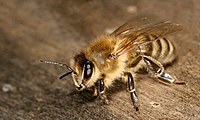
Photo from wikipedia
Stingless bee honey produced by Heterotrigona itama from different botanical origins was characterised and discriminated. Three types of stingless bee honey collected from acacia, gelam, and starfruit nectars were analyzed… Click to show full abstract
Stingless bee honey produced by Heterotrigona itama from different botanical origins was characterised and discriminated. Three types of stingless bee honey collected from acacia, gelam, and starfruit nectars were analyzed and compared with Apis mellifera honey. The results showed that stingless bee honey samples from the three different botanical origins were significantly different in terms of their moisture content, pH, free acidity, total soluble solids, colour characteristics, sugar content, amino acid content and antioxidant properties. Stingless bee honey was significantly different from Apis mellifera honey in terms of physicochemical and antioxidant properties. The amino acid content was further used in the chemometrics analysis to evaluate the role of amino acid in discriminating honey according to botanical origin. Partial least squares-discriminant analysis (PLS-DA) revealed that the stingless bee honey was completely distinguishable from Apis mellifera honey. Notably, a clear distinction between the stingless bee honey types was also observed. The specific amino acids involved in the distinction of honey were cysteine for acacia and gelam, phenylalanine and 3-hydroxyproline for starfruit, and proline for Apis mellifera honey. The results showed that all honey samples were successfully classified based on amino acid content.
Journal Title: Molecules
Year Published: 2019
Link to full text (if available)
Share on Social Media: Sign Up to like & get
recommendations!